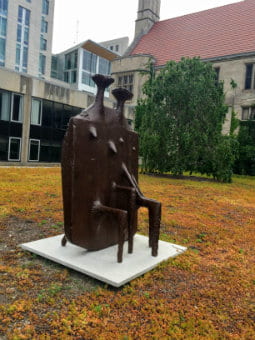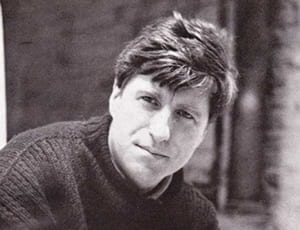Diarchy emerged from a period in Armitage’s career (beginning with 1949’s Linked Figures) when the artist produced many sculptures featuring human forms connected by a flattened, bulky mass. He first became intrigued by the idea of joined anatomies during his time at the Slade School of Fine Arts, where he observed other artists working with terra cotta. When these artists molded multiple human forms, they would often place small nonrepresentational bridges of material between the figures to give them added support. Later, Armitage served as an analyzer of aerial reconnaissance imagery for the British armed forces during WWII. The way three–dimensional structures and aircrafts collapsed into two dimensions in overhead photos captured his imagination. Armitage’s post–war work, including Diarchy, fused these experiences. In the 1950s, he became known for sculpture that was comprised of connected figures and that challenged its own three–dimensionality by introducing a large planar element.
Like much of Armitage’s figural sculpture, Diarchy explores the tension between the concepts of single and multiple. The work’s two “head” forms, its breasts, and its legs are placed approximately where one would expect to find them in relation to each other, lending themselves to the interpretation of the sculpture as two figures. However, the size disparities between the limbs, the left figure’s lack of arms, and the compounding of the forms into one mass give the sculpture a numerical ambiguity. The impression of two distinct figures is undermined by the sense that the sculpture’s appendages might have been borrowed from any number of individuals and attached to this monolithic screen. It becomes unclear whether the representation is single, double, or indefinitely multiple. The wall–like screen extends this ambiguity of numbers to an ambiguity of dimensions. This screen divides the work into two sides, subverting the three–dimensional nature of sculpture. Yet it also extends the sculpture’s three–dimensionality by providing a plane from which the figural elements can jut forward into space.
The grassy alcove where Diarchy is sited is a calm space, removed from busy pedestrian thoroughfares and equipped with benches where one might retreat on a nice day. In this context, the sculpture’s seated figures are imbued with a modest presence. They sit quietly, inhabiting the space in the same unobtrusive way other visitors to the alcove might. The work is dwarfed by its surroundings—the glass facade of the D’Angelo Law Library, the stone towers of Burton–Judson Courts, and the gleaming Construction in Space and in the Third and Fourth Dimensions (by far the more prominent piece of public art in the quadrangle). However, it is precisely because it is upstaged that Diarchy is able to operate on a human scale, despite it being slightly larger than life. In a more well–traveled or private context, the sculpture’s static front–facing figures might read as ominous or threatening; but in this tranquil public locale, their stationary activity is not so different from that of any other visitor to the quadrangle. Here, they can simply share the space. Here, they can engage viewers through curiosity instead of confrontation. Diarchy walks the line between figural representation and a strange hybrid memory.
The piece’s outdoor siting does not come without challenges. By 2011, the sculpture’s surface had become corroded from exposure, and its bronze coloring had turned green and brown. The work was taken off–site for conservation in 2013 concurrently with a landscaping revamp of the Laird Bell Quadrangle. During this time, its surface was repaired and its coloration restored to match that of the companion work at the Tate. It was also coated in an Incralac material to help protect it from graffiti and the elements. The sculpture was returned to its original site and placed upon its same granite base, but the patch of grass it once occupied had been transformed into a floral bed. In addition, a new gravel path had been installed, which would be the closest pedestrian walkway to the piece, so the piece was rotated ninety degrees from its original position to face the new path. Positioned in this space of retreat and contemplation, Diarchy offers visitors the chance to contemplate their own cognition and memory.


